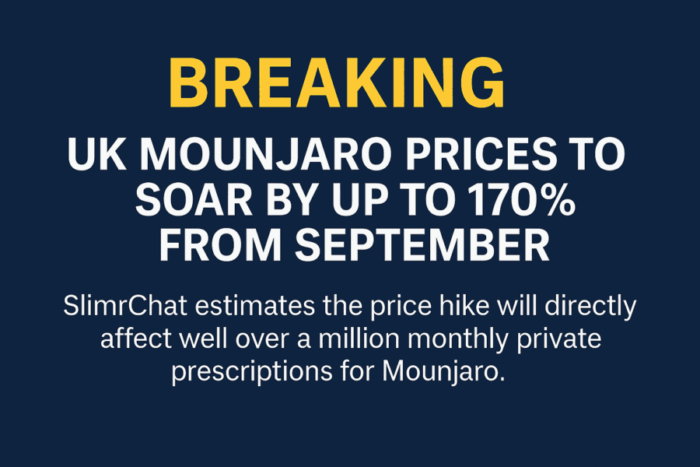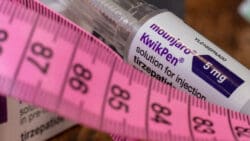Huge Mounjaro price hike hits the UK in September. What you need to know
Robert Price, Peter Paumgardhen | Last update: 15th August 2025
Mounjaro users face steep cost hikes as Eli Lilly aligns UK wholesale prices with Europe. NHS supply will stay the same, but most of us get private prescriptions. SlimrChat estimates the price hike will directly affect well over a million people, so what does it mean?

TL;DR
Eli Lilly is raising UK list prices for Mounjaro by 45% to 170% from 1 September 2025.
NHS prices stay the same, but over a million private Mounjaro prescriptions will be hit.
15 mg dose jumps from £122 to £330 per month (+£2,704/year).
Lilly says it’s aligning with European markets, stopping illegal exports, and funding R&D-under U.S. pressure to narrow price gaps.
SlimrChat warns this could widen the access gap between NHS and private users.
- Novo Nordisk have not announced similar increases for Wegovy but experts warn it is imminent.
UK Mounjaro price hike
Eli Lilly has confirmed it will raise the UK list price of its popular weight-loss and type 2 diabetes drug Mounjaro (tirzepatide) by up to 170% from 1 September 2025. The move brings UK pricing in line with other developed markets and responds to political pressure from the United States to close the gap between US and overseas drug prices.
The company says the increase will not affect NHS supply or costs thanks to an existing agreement with NHS England, but private patients will feel the full impact.
(Source: Financial Times and Reuters)

How much more will it cost?
According to an AAH Pharmaceuticals memo sent to UK providers, here’s how the list prices will change:
| Dose | Current List Price | New List Price | % Increase |
|---|---|---|---|
| 2.5 mg | £92 | £133 | +45% |
| 5 mg | £92 | £180 | +96% |
| 7.5 mg | £107 | £255 | +138% |
| 10 mg | £107 | £255 | +138% |
| 12.5 mg | £122 | £330 | +170% |
| 15 mg | £122 | £330 | +170% |
For example, a patient on the highest 15 mg dose will see their annual list price jump from about £1,586 to £4,290-an extra £2,704 per year before any provider fees.
If you have an NHS prescription for Mounjaro the prescription costs to you will not change, the prices will only affect those paying for the drugs themselves privately.
Why Eli Lilly says it’s raising prices
In statements to Reuters and the Financial Times, Lilly cited several reasons for raising prices:
Aligning UK prices with those of other developed countries after launching at a lower price to speed NHS availability.
Preventing illegal exports to higher-priced markets.
Funding ongoing research and development.
Reflecting new clinical evidence of Mounjaro’s value.
Responding to U.S. political pressure, particularly from President Donald Trump, to raise overseas drug prices and cut US costs.
What should private patients do now?
Check repeat prescriptions before September to lock in current prices if possible.
Ask your doctor about NHS eligibility, especially if you meet NICE criteria for high-need cases.
Plan for higher costs, even with provider discounts; September prices will be much higher.
SlimrChat Take
“This is the biggest single price hike we’ve seen in the UK’s GLP-1 market,” says SlimrChat founder Robert Price. “For over a million private Mounjaro users, it could mean an additional cost to users of hundreds of pounds more a month – or having to stop treatment altogether. And while today’s shock is about Mounjaro, it’s likely Wegovy pricing will follow a similar hike. Both drug makers face the same pressure to match higher prices abroad and stop supply being resold overseas.
The price hikes are significant and the danger is that for many users they become unsustainable. That would be a huge shame as these drugs have proved life-changing for so many people and unfortunately the cost of not tackling obesity is even higher longer-term. Further, a worst case is that users turn to dodgy unauthorised online sellers or fake drugs to cut costs.”
Clearly, this looks like the UK’s comparatively low GLP-1 prices for private patients may be ending.
People will need to weigh the higher out-of-pocket cost against the benefits they’ve achieved. Longer term this could accelerate the push for more NHS provision, alternative suppliers and competitive oral treatments but those developments will take time to materialise.
Further Reading on SlimrChat:
 “This is the biggest single price hike we’ve seen in the UK’s GLP-1 market,” says SlimrChat founder Robert Price. “For over a million private Mounjaro users, it could mean an additional cost to users of hundreds of pounds more a month – or having to stop treatment altogether. And while today’s shock is about Mounjaro, it’s likely Wegovy pricing will follow a similar hike. Both drug makers face the same pressure to match higher prices abroad and stop supply being resold overseas.
“This is the biggest single price hike we’ve seen in the UK’s GLP-1 market,” says SlimrChat founder Robert Price. “For over a million private Mounjaro users, it could mean an additional cost to users of hundreds of pounds more a month – or having to stop treatment altogether. And while today’s shock is about Mounjaro, it’s likely Wegovy pricing will follow a similar hike. Both drug makers face the same pressure to match higher prices abroad and stop supply being resold overseas.